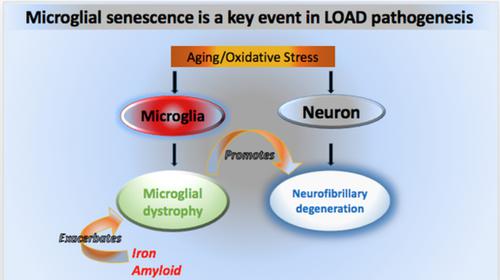Our official English website, www.x-mol.net, welcomes your feedback! (Note: you will need to create a separate account there.)
Dystrophic microglia in late-onset Alzheimer's disease.
Glia ( IF 6.2 ) Pub Date : 2020-01-10 , DOI: 10.1002/glia.23782 Wolfgang J Streit 1 , Habibeh Khoshbouei 1 , Ingo Bechmann 2
Glia ( IF 6.2 ) Pub Date : 2020-01-10 , DOI: 10.1002/glia.23782 Wolfgang J Streit 1 , Habibeh Khoshbouei 1 , Ingo Bechmann 2
Affiliation

|
Here, we summarize current understanding of functional involvement of microglial cells in the most common neurodegenerative disease to affect humans, which is sporadic or late-onset Alzheimer's disease (LOAD). Our review narrowly focuses on insights obtained from post-mortem neuropathological examinations of human brains paying particular attention to microglia as these cells have long been implicated as pivotal players in the cellular processes that lead to AD-type neurodegeneration. Although complete understanding of the roles played by microglia in AD neurodegeneration remains elusive, our studies thus far have illuminated microglial involvement in LOAD, showing that microglial dystrophy, the morphological manifestation of senescence, can be integrated with other hallmark pathological features of AD, such as intraneuronal neurofibrillary degeneration (NFD) and extracellular deposits of amyloid-beta (Aβ) protein. We have demonstrated an in situ correlation between microglial dystrophy and presence of NFD suggesting that neurodegeneration is secondary to aging-related microglial deterioration, a concept founded on the notion that proper neuronal function is dependent on presence of healthy microglia. Diseased or weakened glia are detrimental for neuronal well-being because their ability to provide neuronal support may be impaired. Our most recent work also links microglial dystrophy with Aβ deposits by showing that there is a chronic, yet futile microglial reaction to insoluble amyloid deposits. This inability of microglia to remove aggregated amyloid (a foreign body) causes microglial exhaustion and thereby exacerbates already ongoing aging-dependent microglial deterioration. An eventual total loss of functional microglia in advanced LOAD promotes widespread NFD, dementia, and brain failure.
中文翻译:

营养不良的小胶质细胞在晚期阿尔茨海默氏病中。
在这里,我们总结了当前对小胶质细胞功能参与最常见的神经退行性疾病以影响人类的理解,这是偶发性或迟发性阿尔茨海默氏病(LOAD)。我们的评论狭窄地集中在对人脑的事后神经病理学检查中获得的见解,特别关注小胶质细胞,因为这些细胞长期以来被认为是导致AD型神经变性的细胞过程中的关键参与者。尽管对小胶质细胞在AD神经退行性变中所起的作用的完全了解尚不清楚,但迄今为止,我们的研究阐明了小胶质细胞参与LOAD的情况,表明小胶质细胞营养不良(衰老的形态学表现)可以与AD的其他标志性病理特征整合,例如神经元内神经原纤维变性(NFD)和淀粉样β(Aβ)蛋白的细胞外沉积物。我们已经证明了小胶质细胞营养不良与NFD存在之间的原位相关性,提示神经变性是继发于衰老相关的小胶质细胞退化的基础,这是一个概念,即正确的神经元功能取决于健康的小胶质细胞的存在。患病或虚弱的神经胶质对神经元的健康有害,因为它们提供神经元支持的能力可能受到损害。我们的最新工作还表明,对不溶性淀粉样蛋白沉积物存在慢性但无效的小胶质细胞反应,从而将小胶质细胞营养不良与Aβ沉积物联系起来。小胶质细胞不能去除聚集的淀粉样蛋白(异物)导致小胶质细胞衰竭,从而加剧了已经在持续的衰老相关的小胶质细胞退化。晚期LOAD导致功能性小胶质细胞最终完全丧失,会导致广泛的NFD,痴呆和脑衰竭。
更新日期:2020-01-11
中文翻译:

营养不良的小胶质细胞在晚期阿尔茨海默氏病中。
在这里,我们总结了当前对小胶质细胞功能参与最常见的神经退行性疾病以影响人类的理解,这是偶发性或迟发性阿尔茨海默氏病(LOAD)。我们的评论狭窄地集中在对人脑的事后神经病理学检查中获得的见解,特别关注小胶质细胞,因为这些细胞长期以来被认为是导致AD型神经变性的细胞过程中的关键参与者。尽管对小胶质细胞在AD神经退行性变中所起的作用的完全了解尚不清楚,但迄今为止,我们的研究阐明了小胶质细胞参与LOAD的情况,表明小胶质细胞营养不良(衰老的形态学表现)可以与AD的其他标志性病理特征整合,例如神经元内神经原纤维变性(NFD)和淀粉样β(Aβ)蛋白的细胞外沉积物。我们已经证明了小胶质细胞营养不良与NFD存在之间的原位相关性,提示神经变性是继发于衰老相关的小胶质细胞退化的基础,这是一个概念,即正确的神经元功能取决于健康的小胶质细胞的存在。患病或虚弱的神经胶质对神经元的健康有害,因为它们提供神经元支持的能力可能受到损害。我们的最新工作还表明,对不溶性淀粉样蛋白沉积物存在慢性但无效的小胶质细胞反应,从而将小胶质细胞营养不良与Aβ沉积物联系起来。小胶质细胞不能去除聚集的淀粉样蛋白(异物)导致小胶质细胞衰竭,从而加剧了已经在持续的衰老相关的小胶质细胞退化。晚期LOAD导致功能性小胶质细胞最终完全丧失,会导致广泛的NFD,痴呆和脑衰竭。


























 京公网安备 11010802027423号
京公网安备 11010802027423号